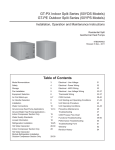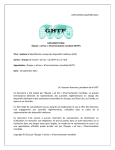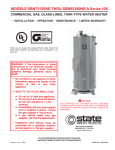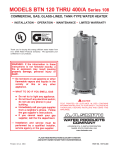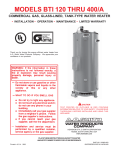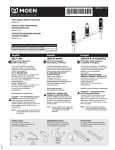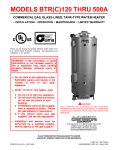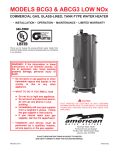Download ClimateMaster GT-PE outdoor Split Series Unit installation
Transcript
AHWG Remote Mount Hot Water Generator Module For GT-PE (50YPS) Series Outdoor Split Unit Installation, Operation & Maintenance Instructions 97B0080N02 Revised: 3 May, 2010B Table of Contents Model Nomenclature Example 3 Description and Installation Examples 4 Installation and Operating Instructions 5-8 Wiring and Electrical Data 9-10 Revision History 12 This page has been intentionally left blank. Remote HWG R e v i s e d : 3 M a y, 2 0 1 0 Model Nomenclature: for Remote Hot Water Generator 1 2 3 5 4 6 7 8 9 AHWG 1 A A C S Accessory Future AHWG = Accessory Remote Hot Water Generator CS = Standard Size 1 = Standard Revision A = Current Revision Voltage A = 115/60/1 G = 208-230/60/1 3 Remote HWG R e v i s e d : 3 M a y, 2 0 1 0 Hot Water Generator Module For Outdoor Compressor Section General Information The HWG Module consists of an all-copper, vented doublewall heat exchanger and a water-cooled bronze water circulating pump. The pump is controlled by a microprocessor in the HWG module. Power for the pump is provided from a remote 115 or 230 vac power source. potential cost of frequent maintenance may offset or exceed any savings. Consult unit IOM for scaling potential tests. The HWG (Hot Water Generator) or desuperheater option provides considerable operating cost savings by utilizing excess heat energy from the heat pump to help satisfy domestic hot water requirements. The HWG may be active throughout the year, providing virtually free hot water when the heat pump operates in the cooling mode or hot water at the COP of the heat pump during operation in the heating mode. Actual HWG water heating capacities are provided in the appropriate heat pump performance data. Figure 1: Typical HWG Installation (Outdoor Compressor Section) Shut-off Valve #1 Shut-off Valve #4 8SSHU HOHPHQWWR 120 - 130°F [49 - 54°C] Shut-off Valve #3 The temperature set point of the HWG is field selectable to 125°F or 150°F . The 150°F set point allows more heat storage from the HWG. For example, consider the amount of heat that can be generated by the HWG when using the 125°F set point, versus the amount of heat that can be generated by the HWG when using the 150°F set point. In a typical 50 gallon two-element electric water heater the lower element should be turned down to 100°F, or the lowest setting, to get the most from the HWG. The tank will eventually stratify so that the lower 80% of the tank, or 40 gallons, becomes 100°F (controlled by the lower element). The upper 20% of the tank, or 10 gallons, will be maintained at 125°F (controlled by the upper element). Cold Inlet from Domestic supply +RW2XWOHW WRKRPH 3RZHUHG :DWHU +HDWHU Shut Off Valve #2 ,QVXODWHGZDWHUOLQHV µ2'IWPD[LPXPRQHZD\PHWHUV >PP2'PHWHUVPD[LPXP@ Figure 2: HWG Double Tank Installation (Outdoor Compressor Section) Hot Outlet to house Cold Inlet Hot Outlet Cold Inlet from Domestic supply Shut-off Valve #1 Using a 125°F set point, the HWG can heat the lower 40 gallons of water from 100°F to 125°F, providing up to 8,330 btu’s of heat. Using the 150°F set point, the HWG can heat the same 40 gallons of water from 100°F to 150°F and the remaining 10 gallons of water from 125°F to 150°F, providing a total of up to 18,743 btu’s of heat, or more than twice as much heat as when using the 125°F set point. Upper element to 130°F [54°C] (or owner preference) Shut-off Valve #4 Shut-off Valve #3 Powered Water Heater Lower element to 120°F [49°C] Unpowered Water Heater Shut Off Valve #2 Field Supplied 3/4” brass nipple and “T” Insulated water lines - 5/8” OD, 50 ft maximum (one way) [16mm OD, 15 meters maximum] This example ignored standby losses of the tank. When those losses are considered the additional savings are even greater. Electric water heaters are recommended. If a gas, propane, or oil water heater is used, a second preheat tank must be installed (Figure 2). If the electric water heater has only a single center element, the dual tank system is recommended to insure a usable entering water temperature for the HWG. Typically a single tank of at least 52 gallons (235 liters) is used to limit installation costs and space. However, a dual tank, as shown in Figure 2, is the most efficient system, providing the maximum storage and temperate source water to the HWG. It is always advisable to use water softening equipment on domestic water systems to reduce the scaling potential and lengthen equipment life. In extreme water conditions, it may be necessary to avoid the use of the HWG option since the 4 /RZHU HOHPHQWWR 100 - 110°F [38 - 43°C] W a t e r- S o u r c e H e a t i n g a n d C o o l i n g S y s t e m s Remote HWG R e v i s e d : 3 M a y, 2 0 1 0 Hot Water Generator Module Refrigeration Installation For Outdoor Compressor Section Only Location/Mounting The HWG module should be mounted indoors and as close to the heat pump outdoor section as possible, in order to minimize the length of refrigerant run. It is recommended that the HWG module be mounted above the system compressor in order to promote proper oil movement and drain-down. This means that the HWG module can be wall mounted in any orientation except for stubs up. Mounting should be accomplished by fastening the HWG module cabinet to the wall or other selected vertical surface. Mounting holes are provided at the rear of the unit. Any fastener suitable for supporting a 12 pound [5.4] vertical load is acceptable. SPECIAL NOTE: The selected mounting location and orientation must allow the circulator pump to be positioned with the motor shaft horizontal. DO NOT install the Heat Recovery Unit flat on its back. Refrigerant Line Installation Before starting the installation into the refrigerant circuit, inspect and note the condition and performance of the heat pump. Disconnect power to the heat pump outdoor unit. Any system deficiencies must be corrected prior to installing the HWG module. Addition of the HWG will not correct system problems. Record the suction and discharge pressures and compressor amperage draw. These may be used for comparison with system operation after the refrigerant line installation is complete. NOTICE! Make sure the compressor discharge line is connected to the “Hot Gas In” stub on the Hot Water Generator. WARNING! WARNING! The HWG module is an appliance that operates in conjunction with the heat pump system, the hot water system and the electrical system. Installation should only be performed by skilled technicians with appropriate training and experience. The installation must be in compliance with local codes and ordinances. Local plumbing and electrical building codes take precedence over instructions contained herein. The Manufacturer accepts no liability for equipment damaged and/or personal injury arising from improper installation of the HWG module. CAUTION! CAUTION! The HWG module must be installed in an area that is not subject to freezing temperatures. CAUTION! CAUTION! Locate Refrigerant lines to avoid accidental damage by lawnmowers or children. Install the Add-On HWG Kit Locate the HWG as close to the water heater as possible. Install the lineset to the desuperheater valves in the outdoor compressor section and the refrigerant line connections on the HWG. Maximum length should be 30 feet one way. Evacuate the lineset to 500 microns through the hot gas valves in the outdoor unit. Open the HWG valves in the compressor section up fully (and close the desuperheater bypass valve). See Figures 3a through 3d. Check the lineset for leaks. Verify that lineset tubing is completely insulated with a minimum 1/2” thick closed cell and painted to prevent deterioration of the insulation due to ultra violet light and weather. Make the connections with high temperature solder or brazing rod. The recommended line size is dependent on the one way distance between the Hot Water Generator and the compressor; and the size of the system. Use Figure 4 as a guideline. 5 Remote HWG R e v i s e d : 3 M a y, 2 0 1 0 Hot Water Generator Module Installation Outdoor Compressor Section Only Figure 3a: Outdoor Compressor Section HWG Installation Figure 3c: HWG Service Valves Refr to HWG HWG Bypass Valve Refr from HWG Refr to HWG HWG Line Valves Refr from HWG Fully Insulated Lines to the HWG Figure 3b: Remote HWG Module Figure 4: HWG Refrigerant Line Sizing Control Board HWG Refr Out HWG Water Out HWG Refr In 16.2” Circulator High Voltage Line Set Size 1/2” OD 5/8” OD 3/4” OD 2 Ton Up to 16 ft. [4.9m] Up to 30 ft. [9.1m] N/A 3 Ton Up to 9 ft. [2.7m] Up to 25 ft. [7.6m] Up to 30 ft. [9.1m] 4 Ton Up to 5 ft. [1.5m] Up to 13 ft. [4.0m] Up to 30 ft. [9.1m] 5 Ton N/A Up to 9 ft. [2.7m] Up to 25 ft. [7.6m] 7.1” Low HWG Voltage Water In 11.1” Capacity HWG Water In Figure 3d: HWG Bypass Valve As a guideline add 1.0 oz. of refrigerant for the heat exchanger plus 1.0 oz. for each 10 ft of 1/2” OD refrigerant line, if the weighed charge method is used (28g for the heat exchanger plus 9g per meter of 1/2” OD refrigerant line). Valve Open (HWG Bypassed) 6 Valve Closed (HWG Activated) W a t e r- S o u r c e H e a t i n g a n d C o o l i n g S y s t e m s Remote HWG R e v i s e d : 3 M a y, 2 0 1 0 Hot Water Generator Module Installation The HWG is controlled by two sensors and a microprocessor control. One sensor is located on the compressor discharge line to sense the discharge refrigerant temperature. The other sensor is located on the HWG heat exchanger’s “Water In” line to sense the potable water temperature. ANTI-SCALD VALVE PIPING CONNECTIONS ANTI-SCALD VALVE WARNING! The microprocessor control monitors the refrigerant and water temperatures to determine when to operate the HWG. The HWG will operate any time the refrigerant temperature is sufficiently above the water temperature. Once the HWG has satisfied the water heating demand during a heat pump run cycle, the controller will cycle the pump at regular Intervals to determine if an additional HWG cycle can be utilized. The microprocessor control Includes 3 DIP switches, SW10 (HWG PUMP TEST), SW11 (HWG TEMP), and SW12 (HWG STATUS). SW10 HWG PUMP TEST. When this switch is in the “ON” position, the HWG pump is forced to operate even if there is no call for the HWG. This mode may be beneficial to assist in purging the system of air during Initial start up. When SW10 is in the “OFF” position, the HWG will operate normally. This switch is shipped from the factory in the “OFF” (normal) position. NOTE; If left in the “On” position for 5 minutes, the pump control will revert to normal operation. SW11 HWG TEMP. The control setpoint of the HWG can be set to either of two temperatures, 125°F or 150°F. When SW11 is in the “ON” position the HWG setpoint is 150°F. When SW11 is in the “OFF” position the HWG setpoint is WARNING! WARNING! USING A 150°F SETPOINT ON THE HWG WILL RESULT IN WATER TEMPERATURES SUFFICIENT TO CAUSE SEVERE PHYSICAL INJURY IN THE FORM OF SCALDING OR BURNS, EVEN WHEN THE HOT WATER TANK TEMPERATURE SETTING IS VISIBLY SET BELOW 150°F. THE 150°F HWG SETPOINT MUST ONLY BE USED ON SYSTEMS THAT EMPLOY AN APPROVED ANTISCALD VALVE (MANUFACTURER PART NUMBER AVAS4) AT THE HOT WATER STORAGE TANK WITH SUCH VALVE PROPERLY SET TO CONTROL WATER TEMPERATURES DISTRIBUTED TO ALL HOT WATER OUTLETS AT A TEMPERATURE LEVEL THAT PREVENTS SCALDING OR BURNS! HOT WATER TO HOUSE C M H 8” MAX WARNING! UNDER NO CIRCUMSTANCES SHOULD THE SENSORS BE DISCONNECTED OR REMOVED AS FULL LOAD CONDITIONS CAN DRIVE HOT WATER TANK TEMPERATURES FAR ABOVE SAFE TEMPERATURE LEVELS IF SENSORS HAVE BEEN DISCONNECTED OR REMOVED. CHECK VALVE COLD WATER SUPPLY WATER HEATER 125°F. This switch Is shipped from the factory in the “OFF” (125°F) position. SW12 HWG STATUS. This switch controls operation of the HWG. When SW12 is in the “ON” position the HWG is disabled and will not operate. When SW12 is in the “OFF” position the HWG is in the enabled mode and will operate normally. This switch is shipped from the factory in the “ON” (disabled) position. CAUTION: DO NOT PLACE THIS SWITCH IN THE ENABLED POSITION UNITL THE HWG PIPING IS CONNECTED, FILLED WITH WATER, AND PURGED OR PUMP DAMAGE WILL OCCUR. When the control is powered and the HWG pump output is not active, the status LED (AN1) will be “On”. When the HWG pump output is active for water temperature sampling or HWG operation, the status LED will slowly flash (On 1 second, Off 1 second). If the control has detected a fault, the status LED will flash a numeric fault code as follows: Hot Water Sensor Fault Compressor Discharge sensor fault High Water Temperature (>160ºF) Control Logic Error 1 flash 2 flashes 3 flashes 4 flashes Fault code flashes have a duration of 0.4 seconds with a 3 second pause between fault codes. For example, a “Compressor Discharge sensor fault” will be four flashes 0.4 seconds long, then a 3 second pause, then four flashes again, etc. 7 Remote HWG R e v i s e d : 3 M a y, 2 0 1 0 Hot Water Generator Module - Domestic Water Installation WARNING! Warning! Use extreme caution when working around the microprocessor control as it contains line voltage connections that presents a shock hazard that can cause severe injury or death! The heat pump, water piping, HWG, and hot water tank should be located where the ambient temperature does not fall below 50°F [10°C]. Keep water piping lengths at a minimum. DO NOT use a one way length greater than 50 ft. (one way) [15 m]. All installations must be in accordance with local codes. The installer is responsible for knowing the local requirements, and for performing the installation accordingly. DO NOT connect the pump wiring until “Initial Start-Up” section, below. Powering the pump before all installation steps are completed may damage the pump. Water Tank Preparation 1. Turn off power or fuel supply to the hot water tank. 2. Connect a hose to the drain valve on the water tank. 3. Shut off the cold water supply to the water tank. 4. Open the drain valve and open the pressure relief valve or a hot water faucet to drain tank. 5. When using an existing tank, it should be flushed with cold water after it is drained until the water leaving the drain hose is clear and free of sediment. 6. Close all valves and remove the drain hose. 7. Install HWG water piping. HWG Water Piping 1. Using at least 5/8” [16mm] O.D. copper, route and install the water piping, valves and air vent as shown in Figures 1 or 2. Install an approved anti-scald valve if the 150°F HWG setpoint is or will be selected. An appropriate method must be employed to purge air from the HWG piping. This may be accomplished by flushing water through the HWG (as In Figures 1 and 2) or by Installing an air vent at the high point of the HWG piping system. 2. Insulate all HWG water piping with no less than 3/8” [10mm] wall closed cell insulation. 3. Open both shut off valves and make sure the tank drain valve is closed. Water Tank Refill 1. Close valve #4. Ensure that the HWG valves (valves #2 and #3) are open. Open the cold water supply (valve #1) to fill the tank through the HWG piping. This will purge air from the HWG piping. 2. Open a hot water faucet to vent air from the system until water flows from faucet; turn off faucet. Open valve #4. 3. Depress the hot water tank pressure relief valve handle to ensure that there is no air remaining in the tank. 4. Inspect all work for leaks. 8 5. Before restoring power or fuel supply to the water heater, adjust the temperature setting on the tank thermostat(s) to insure maximum utilization of the heat available from the refrigeration system and conserve the most energy. On tanks with both upper and lower elements and thermostats, the lower element should be turned down to 100°F [38°C] or the lowest setting; the upper element should be adjusted to 120-130°F [49-54°C]. Depending upon the specific needs of the customer, you may want to adjust the upper element differently. On tanks with a single thermostat, a preheat tank should be used (Fig 2). 6. Replace access cover(s) and restore power or fuel supply. Initial Start-Up 1. Make sure all valves in the HWG water circuit are fully open. 2. Make electrical connections (power and low voltage) as shown on the HWG wiring diagram. Example wiring diagrams and an electrical data table are included in this document (See Figures 5-8). 3. Turn the heat pump power and remote HWG power “off” and switch dip switch SW12 on the HWG controller to the “off” (enabled) position to activate the HWG. 4. Allow the unit to operate for 20 to 30 minutes insure that it is functioning properly. 5. The HWG pump should not run if the compressor is not running. 6. The temperature difference between the water entering and leaving the HWG should be approximately 5-10 °F [3-6 °C]. Servicing 1. Always turn dip switch SW12 on the HWG controller to the “on” (disabled) position to deactivate the HWG when servicing the outdoor compressor section. HWG Water Piping Size and Length Unit Nominal Tonnage Nominal HWG Flow (gpm) 1/2" Copper (max length*) 3/4" Copper (max length*) 1.5 0.6 50 - 2.0 0.8 50 - 2.5 1.0 50 - 3.0 1.2 50 - 3.5 1.4 50 - 4.0 1.6 45 50 5.0 2.0 25 50 6.0 2.4 10 50 *Maximum length is equivalent length one way of type L copper. W a t e r- S o u r c e H e a t i n g a n d C o o l i n g S y s t e m s Remote HWG R e v i s e d : 3 M a y, 2 0 1 0 Electrical - Wiring Figure 5: HWG Module Wiring 230 Volt CONDENSER CONDENSER CONDENSER HWG Module Figure 6: HWG Module Wiring 115 volt HWG Module Wiring - For “Outdoor” Compressor Section The HWG module should be wired to a power supply as shown in Figure 5 or 6. A safety disconnect should be installed at the HWG module as required by code to allow servicing of the module. DO NOT energize the pump until all HWG piping is completed and air is purged from the water piping to avoid running the pump “dry”. E E E Figure 7: HWG Module Electrical Data HWG Module Voltage Pump FLA Total FLA Min Circuit Amps Min Wire Size AHWG1AACS 115/60/1 0.52 0.52 1.20 14 ga. AHWG1AGCS 208/230/60/1 0.40 0.40 0.90 14 ga. WARNING! WARNING! To avoid possible injury or death due to electrical shock, open the power supply disconnect switch and secure it in an open position during installation. CAUTION! CAUTION! Use only copper conductors for field installed electrical wiring. Unit terminals are not designed to accept other types of conductors. 9 Remote HWG R e v i s e d : 3 M a y, 2 0 1 0 Electrical - Wiring Figure 8: Low Voltage Field Wiring WARNING! WARNING! To avoid possible injury or death due to electrical shock, open the power supply disconnect switch and secure it in an open position during installation. 10 CAUTION! CAUTION! Use only copper conductors for field installed electrical wiring. Unit terminals are not designed to accept other types of conductors. W a t e r- S o u r c e H e a t i n g a n d C o o l i n g S y s t e m s Remote HWG R e v i s e d : 3 M a y, 2 0 1 0 Notes: 11 Remote HWG R e v i s e d : 3 M a y, 2 0 1 0 Revision History Date Page # Description 1 July, 10 Various Warranty, Nomenclature, Unit Photos Updated 3 May, 10 4 HWG Piping Drawings Revised 3 Nov., 09 All First Published ISO 9001:2000 Certified Quality: First & Always 7300 S.W. 44th Street *97B0080N02* Oklahoma City, OK 73179 Phone: 405-745-6000 Fax: 405-745-6058 97B0080N02 The Manufacturer works continually to improve its products. As a result, the design and specifications of each product at the time for order may be changed without notice and may not be as described herein. Please contact the Manufacturer’s Customer Service Department at 1-405-7456000 for specific information on the current design and specifications. Statements and other information contained herein are not express warranties and do not form the basis of any bargain between the parties, but are merely the Manufacturer’s opinion or commendation of its products. The management system governing the manufacture of the Manufacturer’s products is ISO 9001:2000 certified. © LSB, Inc. 2009 12 W a t e r- S o u r c e H e a t i n g a n d C o o l i n g S y s t e m s Revised: 1 May, 2010B












